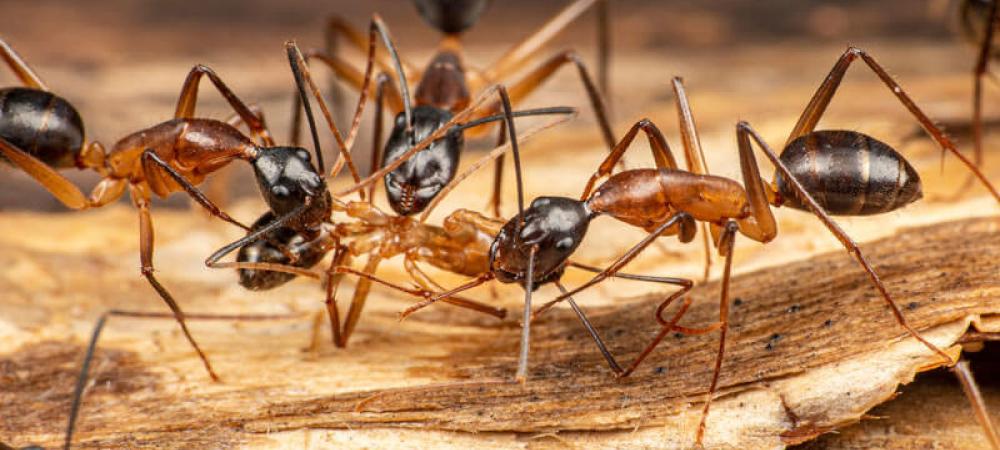What Do Insects Eat?

Let's be real here. We all secretly (or not so secretly) want to know what the creepy crawlies in our backyard are chowing down on. I mean, who wouldn't want to know if ants prefer ketchup or mustard?
Well, your bug-loving prayers have been answered! We've put together a list of the most delectable delights for our six-legged friends. And let me tell you, it's not just leaves and twigs like you might expect. These little critters have some seriously exotic tastes.
Today we're going to dive into the wild and wacky world of insect cuisine!
First, What Are Insects?
Insects are a diverse group of animals that can be found all over the world. They are characterized by their six legs, three body segments, and two antennae. But don't let their small size fool you, insects make up over 80% of all living species on Earth! That's more than all the stars in the Milky Way galaxy combined.
One of the most fascinating things about insects is their diversity. There are over a million known species of insects and scientists estimate that there may be up to 30 million more that haven't been discovered yet. That's more than all the episodes of your favorite TV show!
Insects also play important roles in many ecosystems, from pollinating plants to serving as food for other animals. Without insects, our world would be a very different place.
And What Do They Eat?
With over a million descents in the insect world, it can be incredibly difficult to keep track of what these little critters are munching on. But enough about us humans, what do insects eat? The answer is: just about anything!
Insects are opportunistic feeders and will chow down on just about anything they can get their mandibles on. This can include nectar, pollen, fruit, leaves, wood, and even other insects. But don't worry, most insects won't be chomping on your flesh.
Most insects subsist on a diet consisting primarily of plants and fruits. Many species of bugs such as butterflies, moths, bees, and beetles are herbivorous while others may prefer sweet nectar or sugary sap.
Some bugs will even feed off other insects such as aphids or caterpillars. These carnivorous critters have developed specialized mouthparts that enable them to puncture their prey and suck out their soft insides like little juice boxes- how crazy is that?
In addition to plants and other bugs, some insects also enjoy fun treats like honeydew from scale insects or mealybugs which can often be found in gardens or fields. While many bug diets consist predominantly of plant matter, there are some interesting exceptions like thrips which rely solely on pollen for sustenance. This begs the question: how do they obtain all this yummy food?
Well, when it comes to getting their grub on, insects really know how to get the job done. Most rely heavily on foraging techniques such as scouring leaves and stems for tasty morsels or probing crevices for hidden goodies. Others use various hunting tactics including ambushing prey with lightning fast reflexes or even stalking them in packs!
The Most Unusual Insect Food
Insects have evolved over time to eat some of the strangest and most exotic foods imaginable. From vampire moths to crocodile tears, here are just a few of the most unusual insect eats that you'll find in your backyard.
The Vampire Moth
Who knew a tiny little moth could survive on nothing but mammal blood? Well, it turns out they actually do, and they’ll even suck their victims dry if they’re not careful! Poetically known as “vampire moths," these nocturnal insects will hover around mammals like cows and horses then feed on their blood through small openings in the skin. While one bite won’t cause any harm to the animal, it can still be pretty unnerving.
The Ant That Eats Crocodile Tears
Even ants need hydration — but instead of drinking water, some ants turn to an unexpected source — crocodile tears! These tiny creatures will crawl up onto a crocodile’s face and drink from its eyes! They get a salty snack while providing a much-needed cleaning service for their scaly host.
The Dung Beetle
As gross as it sounds, dung beetles actually have a very important job — breaking down animal feces. Although most dung beetles feed off of cow dung or other sources of organic waste, there is one species that prefers elephant droppings. The aptly named “elephant dung beetle" makes its home in Africa's savannas feeding off this nutrient-rich fertilizer until it's ready to lay its eggs inside the steaming pile.
Insects aren't the only critters with an appetite for the weird and wonderful; plants provide plenty of culinary options for bugs too. From carnivorous plants like Venus flytraps to bromeliads that catch prey with their leaves – there are plenty of bug eating plants out there waiting to snap up unsuspecting food sources.
Some plants even produce sweet-smelling nectar which can attract certain insects like bees or butterflies into their trap! A plant might look harmless at first glance – but don’t let appearances fool you – some are true predators in disguise!
What Do Carnivorous Insects Eat?
Now, let's talk about the carnivorous insects, also known as the bug-eaters. Do they have a diet as diverse as their shapes and sizes? The answer is yes!
But first, let's define what makes an insect carnivorous. These omnivores feed mainly on other insects, spiders and small amphibians like frogs or tadpoles. They also tend to be predators — they actively hunt down their prey — unlike some other insects that simply scavenge for food.
Praying mantises are one of the most beloved carnivorous insects out there. Despite having teeny-tiny stomachs, these creatures are actually quite voracious hunters that feast mostly on flies and other small bugs. But don’t be fooled by their sluggish movements; when it comes time for dinner, praying mantises can execute lightning-fast strikes at unsuspecting prey!
Dragonflies are another popular species of carnivorous insect — and they have an appetite to match their formidable size! Dragonflies love gobbling up mosquitos in midair whilst performing stunning acrobatic maneuvers in pursuit of their prey. But what about when dragonflies aren’t hungry? Well, don't worry - they also enjoy ‘catching’ food just for fun!
Carnivorous beetles form another large chunk of the insect predator population. These pesky critters feed mainly on soft-bodied invertebrates like worms and slugs. Luckily for us humans, these beetles tend to stay away from our food supplies — unless your kitchen has been taken over by snails or millipedes!
Let's not forget about those squishy little spider-like arachnids known as "true bugs." A lot of true bugs are omnivores or herbivores but some species do prefer meaty treats or sugary snacks (yes really!). For example, a certain family of true bugs called assassin bugs feed mostly on caterpillars and aphids while members of the shield bug family feast exclusively on plant juices like nectars from flowers or juices from fruits — talk about picky eaters!
What Do Herbivorous Insects Eat?
But not all insects are meat-eaters, some prefer a plant-based diet. These herbivorous insects include caterpillars and grasshoppers.
So, what do these herbivorous insects eat?
Mostly plants!
Caterpillars and grasshoppers are two well-known examples of herbivorous insects. These creatures munch on leaves, flowers, and other plant parts to get the nutrition they need.
Herbivorous insects have specialized mouthparts that help them feed on plants. For example, caterpillars have chewing mouthparts that allow them to take big bites out of leaves. Some grasshoppers have piercing and sucking mouthparts that they use to pierce plant tissue and suck out the juices.
Feeding on plants can be a risky business for herbivorous insects. Plants defend themselves against being eaten by producing chemicals that can be toxic to insects. To counter this, many herbivorous insects have evolved ways to detoxify these chemicals or simply tolerate them. Some caterpillars even incorporate the toxins into their own bodies as a way to deter predators!
Herbivorous insects play an important role in ecosystems by serving as food for other animals. Many birds, reptiles, amphibians, and mammals depend on these creatures for sustenance. In some cases, entire food webs depend on the relationship between herbivorous insects and the animals that eat them.
The Impact of Human Activities on Insect Diets
Now, you might be thinking, "That's all well and good, but what does this have to do with me?" Well, human activities such as deforestation and pesticide use can have a big impact on the insect food chain.
When it comes to the impact of human activities on insect diets, it's not all doom and gloom. Sure, deforestation and the use of pesticides have had a negative effect on many insect populations, leading to an imbalance in the food chain - but there are still things we can do to help protect our six-legged friends.
One of the most important things we can do is reduce deforestation. This helps insects by providing them with more habitats where they can feed and breed. We can also reduce pesticide use as much as possible so that these chemicals don't kill off any beneficial bugs. Additionally, we should focus on growing native plants and flowers in our gardens, which will produce nectar that attracts a variety of insects. Many species rely on these sources for their food!
It might seem like a small thing but planting pollinator-friendly flora helps encourage biodiversity, which is key to a healthy ecosystem. And if you're feeling particularly adventurous, you could start your very own insect hotel! These little structures provide sheltered areas for various types of bugs to rest during the day and feast throughout the night – a perfect way to attract even more pollinators into your garden.
We should also remember that there are some pretty outrageous culinary delights out there in the insect world. From cricket tacos to fried mealworms – who knows, maybe one day your average restaurant menu will include something totally wacky yet delicious!
Q: Do butterflies drink blood?
A: No, they're more into nectar and pollen.
Q: Do grasshoppers eat ants?
A: It's not a common practice but they are known to eat small insects like ants.
Q: What do ladybugs eat?
A: Ladybugs are not just cute, they're also voracious eaters. They munch on aphids, mites, and other small insects, making them the farmers' best friend.
Wrap Up!
Bugs are like the buffet kings and queens of the animal kingdom, they'll chow down on just about anything, from their bug buddies, to plants and even nectar and pollen. But don't worry, most of them won't be chomping on you.
And let's not forget, some plants are bug eaters too, like the Venus flytrap, it's like a bug buffet in a plant. So next time you see a bug, don't be so quick to squish it, it might just be doing its part to keep the ecosystem in check. But if you are dealing with a pest infestation, call Whitmore for professional extermination services!

